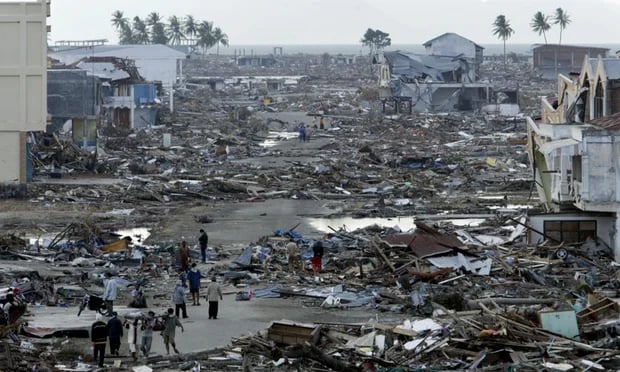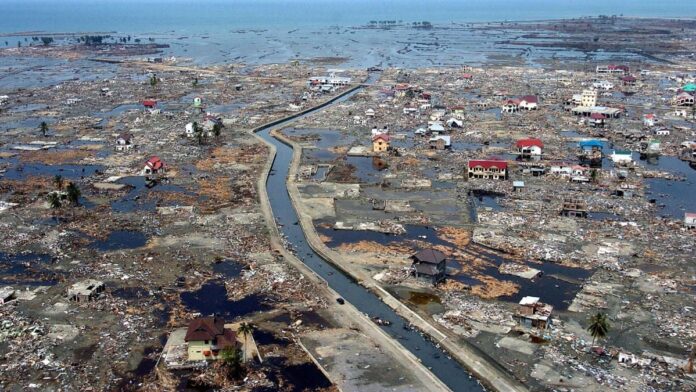On December 26, 2004, a catastrophic 9.1-magnitude earthquake off Sumatra, Indonesia, triggered a tsunami, resulting in the deaths of millions across multiple countries, reaching as far as East Africa. This unprecedented disaster profoundly altered global disaster response strategies and fostered international solidarity.
The 2004 Indian Ocean earthquake and tsunami is considered one of the worst natural disasters in modern history. Occurring just before 7:59 am, the earthquake initiated the most prolonged faultline rupture ever recorded, extending over 1,200 kilometres. The tsunami produced devastating waves over 30 meters high, releasing energy equivalent to 23,000 atomic bombs. While an initial magnitude of 8.8 was reported, the US Geological Survey later confirmed it at 9.1, with a depth of 30 kilometres.

Mapping the Earthquake | YouTube
The epicenter was approximately 241 kilometres from Sumatra’s coast, in Indonesia, which lies along the Pacific “Ring of Fire,” a highly seismic region. The death toll was staggering, with the official disaster database EM-DAT reporting 226,408 fatalities. The tsunami struck Thailand, India, and Sri Lanka within hours, traveling at speeds exceeding 800 kilometres per hour, more than twice that of a bullet train. Sri Lanka suffered nearly 35,000 deaths, India reported 16,389, and Thailand experienced 8,345 casualties.

2004 Indian Ocean Earthquake And Tsunami |
Aceh province in Indonesia suffered the most, with over half of the total deaths (126,000) occurring there, especially in Aceh Besar and Banda Aceh. The disaster severely affected various other regions, with approximately 300 fatalities in Somalia, more than 100 in the Maldives, and numerous victims reported in Malaysia and Myanmar. The tragedy serves as a solemn reminder as the 20th anniversary approaches, highlighting the necessity for enhanced disaster preparedness and global cooperation.

2004 Indian Ocean Earthquake And Tsunami | AP
The devastation caused by the 2004 tsunami displaced more than 1.5 million people, particularly in the four worst-affected nations: Indonesia, Sri Lanka, India and Thailand. Hundreds of thousands of schools, hospitals and basic infrastructure were destroyed, leaving many communities homeless. A 2019 report by the Tsunami and Disaster Mitigation Research Center at Syiah Kuala University in Aceh recorded more than 1,400 schools destroyed and nearly 150,000 students with their education interrupted due to the destructive waves.

2004 Indian Ocean Earthquake And Tsunami |
In the face of this tragedy, numerous donors and international organizations injected funds for reconstruction, resulting in approximately $14 billion in relief pledged by the international community, according to the United Nations. Today, recovery has transformed the hardest-hit city, Banda Aceh, where the Indonesian government reports that more than 100,000 homes have been rebuilt. Three “escape buildings” were also erected in relatively safer areas to house thousands of people in the event of a future earthquake or tsunami.

2004 Indian Ocean Earthquake And Tsunami | Britannica
Twenty years after the disaster, Aceh’s coast has been reborn, with a proliferation of homes, cafes, restaurants and tourist facilities, while in some areas, sand and stone are being quarried from the surrounding hills.

2004 Indian Ocean Earthquake And Tsunami | wikipedia
The tsunami prompted coastal communities in the Indian Ocean to re-evaluate their preparedness. At the time of the earthquake, there was no warning system in the region. Now, with 1,400 stations around the world, warning times have been reduced to a few minutes after a tsunami wave forms. Experts warn that although millions have been invested in warning systems, the impact of a catastrophic tsunami cannot be completely eliminated.








